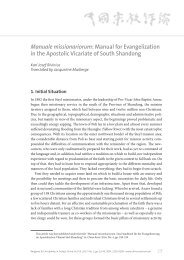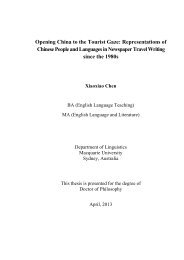EDUCATION IN CHINA
Education-in-China-a-snapshot
Education-in-China-a-snapshot
Create successful ePaper yourself
Turn your PDF publications into a flip-book with our unique Google optimized e-Paper software.
Introduction<br />
Guangdong is located in the southernmost part of<br />
China’s mainland, and is bordered by the country’s two<br />
special administrative regions: Hong Kong and Macau.<br />
Guangzhou is the provincial capital of Guangdong. It is<br />
home to a special economic zone, Shenzhen, which was<br />
also the first special economic zone established after the<br />
reforms and economic opening up of the country in the<br />
early 1980s. Guangzhou and Shenzhen are major cities in<br />
China that are comparable to Beijing and Shanghai. The<br />
four cities play important roles in national politics and<br />
in the economy. Since 1989, Guangdong has topped the<br />
total GDP rankings among all provincial-level divisions.<br />
However, it also has the largest population, and its GDP<br />
per capita only ranks in the top third of all provinciallevel<br />
divisions.<br />
Guangdong hosts the largest import and export fair<br />
in China, the Canton Fair in Guangdong’s capital city,<br />
Guangzhou. Guangdong is also the oldest foreign trade<br />
port, and the starting point of the Maritime Silk Road.<br />
Foreign trade brings a tradition of openness to the city,<br />
which makes the province active in various reforms<br />
alongside Shanghai.<br />
Guangdong has unique styles of language, tradition<br />
and culture. The oral language used by most citizens<br />
is Cantonese, which is not mutually intelligible with<br />
Mandarin, the most widely used Chinese. One of the most<br />
notable differences between Cantonese and Mandarin<br />
is how the spoken word is written: with Mandarin the<br />
spoken word is written as such, whereas with Cantonese<br />
there may not be a direct written word matching what<br />
is said. This results in the situation in which Mandarin<br />
and Cantonese texts look almost the same, but are<br />
pronounced differently. People in Hong Kong and Macau<br />
also speak Cantonese, which is mutually intelligible with<br />
the Cantonese spoken in Guangdong, although there are<br />
minor differences in accent and vocabulary. Sharing the<br />
same oral language can, to some degree, facilitate the<br />
cooperation and communication in education (Box 6.1).<br />
Box 6.1 Languages in China<br />
The languages spoken in China belong to the Sino-Tibetan<br />
language family and are comprised of hundreds of local<br />
dialects, many of which are not mutually intelligible.<br />
Predominantly, languages in China can be divided into<br />
seven dialect groups: Mandarin, Yue (Cantonese), Hakka,<br />
Min, Wu, Gan and Xiang (Ministry of Education, 2013).<br />
Despite much language diversity, the Chinese use a unified<br />
script system for writing that facilitates communication in<br />
general, and education in particular.<br />
Originating from the northern dialects, Mandarin is both<br />
the official language and the language of basic education<br />
in mainland China. With the increase in literacy, Mandarin<br />
is understood in most parts of China. As a result, “Chinese”<br />
usually means Mandarin. Yue is spoken in Guangdong,<br />
Guangxi, Hong Kong and Macau. The most common form of<br />
Yue is Cantonese, which is spoken in the city of Guangzhou.<br />
Cantonese is also the native language of the majority of<br />
citizens in Hong Kong and Macau. The Hakka dialect is<br />
spoken by a group of Han Chinese living in the hills of<br />
northeast Guangdong and in many other parts of southern<br />
China, as well as Chinese Taipei. Min is mostly spoken in<br />
Fujian, eastern Guangdong, Hainan and Chinese Taipei.<br />
Wu is spoken in Shanghai, Zhejiang, southern Jiangsu<br />
and Anhui. Wu is comprised of hundreds of distinct<br />
spoken forms, many of which are not mutually intelligible.<br />
The Suzhou dialect is the most well-known form of Wu.<br />
Phonological differences mark the Chinese dialects rather<br />
than differences in vocabulary and syntax.<br />
Nearly all students in mainland China can speak and<br />
write in Mandarin, since Mandarin enjoys the status of an<br />
official language and is used as the medium of instruction<br />
in schools. However, Cantonese and Min are also widely<br />
known in the mainland. In Hong Kong and Macau, students<br />
are versed in Cantonese rather than Mandarin.<br />
There are two types of characters in the Chinese written<br />
script: simplified Chinese characters and traditional Chinese<br />
characters. As its name indicates, simplified characters are<br />
simplified from the original written form, i.e. the traditional<br />
Chinese characters. The first official round of official<br />
character simplification was released in two documents<br />
in 1956 and 1964. This was followed by other rounds of<br />
simplification, as the aim of the transformation was to help<br />
increase literacy. People who have learned the simplified set<br />
of characters can also understand the traditional Chinese<br />
characters with little additional effort.<br />
From the beginning of China’s economic opening up and<br />
reforms to year 2013, the urbanisation rate of Guangdong<br />
shifted dramatically from 16.3% to 67.76%, ranking it first<br />
among all the provinces, but excluding municipalities<br />
like Beijing and Shanghai (Xinhua News Agency, 2015a).<br />
The Pearl River Delta is also one of the largest city groups<br />
in China.<br />
52 – <strong>EDUCATION</strong> <strong>IN</strong> CH<strong>IN</strong>A: A SNAPSHOT © OECD 2016





